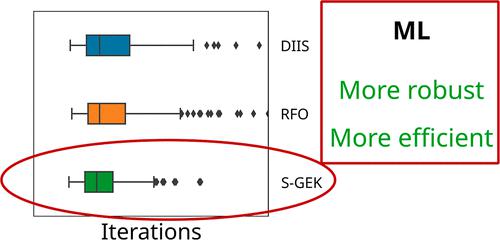当前位置:
X-MOL 学术
›
J. Phys. Chem. A
›
论文详情
Our official English website, www.x-mol.net, welcomes your feedback! (Note: you will need to create a separate account there.)
A Story of Three Levels of Sophistication in SCF/KS-DFT Orbital Optimization Procedures
The Journal of Physical Chemistry A ( IF 2.9 ) Pub Date : 2024-03-14 , DOI: 10.1021/acs.jpca.3c07647 Daniel Sethio 1, 2 , Emily Azzopardi 1 , Ignacio Fdez. Galván 1 , Roland Lindh 1, 3
The Journal of Physical Chemistry A ( IF 2.9 ) Pub Date : 2024-03-14 , DOI: 10.1021/acs.jpca.3c07647 Daniel Sethio 1, 2 , Emily Azzopardi 1 , Ignacio Fdez. Galván 1 , Roland Lindh 1, 3
Affiliation

|
In this work, three versions of self-consistent field/Kohn–Sham density functional theory (SCF/KS-DFT) orbital optimization are described and benchmarked. The methods are a modified version of the geometry version of the direct inversion in the iterative subspace approach (which we call r-GDIIS), the modified restricted step rational function optimization method (RS-RFO), and the novel subspace gradient-enhanced Kriging method combined with restricted variance optimization (S-GEK/RVO). The modifications introduced are aimed at improving the robustness and computational scaling of the procedures. In particular, the subspace approach in S-GEK/RVO allows the application to SCF/KS-DFT optimization of a machine learning technique that has proven to be successful in geometry optimizations. The performance of the three methods is benchmarked for a large number of small- to medium-sized organic molecules, at equilibrium structures and close to a transition state, and a second set of molecules containing closed- and open-shell transition metals. The results indicate the importance of the resetting technique in boosting the performance of the r-GDIIS procedure. Moreover, it is demonstrated that already at the inception of the subspace version of GEK to optimize SCF wave functions, it displays superior and robust convergence properties as compared to those of the standard state-of-the-art SCF/KS-DFT optimization methods.
中文翻译:

SCF/KS-DFT 轨道优化过程的三个复杂程度的故事
在这项工作中,描述了自洽场/Kohn-Sham 密度泛函理论 (SCF/KS-DFT) 轨道优化的三个版本并进行了基准测试。这些方法是迭代子空间方法中直接反演的几何版本的修改版本(我们称为 r-GDIIS)、修改的限制步有理函数优化方法(RS-RFO)以及新颖的子空间梯度增强克里金法方法结合限制方差优化(S-GEK/RVO)。引入的修改旨在提高程序的鲁棒性和计算规模。特别是,S-GEK/RVO 中的子空间方法允许将机器学习技术应用于 SCF/KS-DFT 优化,该技术已被证明在几何优化方面是成功的。这三种方法的性能以大量处于平衡结构且接近过渡态的中小型有机分子以及包含闭壳和开壳过渡金属的第二组分子为基准。结果表明重置技术在提高 r-GDIIS 过程性能方面的重要性。此外,事实证明,在用于优化 SCF 波函数的 GEK 子空间版本一开始,与标准的最先进的 SCF/KS-DFT 优化方法相比,它就显示出卓越且稳健的收敛特性。
更新日期:2024-03-14
中文翻译:

SCF/KS-DFT 轨道优化过程的三个复杂程度的故事
在这项工作中,描述了自洽场/Kohn-Sham 密度泛函理论 (SCF/KS-DFT) 轨道优化的三个版本并进行了基准测试。这些方法是迭代子空间方法中直接反演的几何版本的修改版本(我们称为 r-GDIIS)、修改的限制步有理函数优化方法(RS-RFO)以及新颖的子空间梯度增强克里金法方法结合限制方差优化(S-GEK/RVO)。引入的修改旨在提高程序的鲁棒性和计算规模。特别是,S-GEK/RVO 中的子空间方法允许将机器学习技术应用于 SCF/KS-DFT 优化,该技术已被证明在几何优化方面是成功的。这三种方法的性能以大量处于平衡结构且接近过渡态的中小型有机分子以及包含闭壳和开壳过渡金属的第二组分子为基准。结果表明重置技术在提高 r-GDIIS 过程性能方面的重要性。此外,事实证明,在用于优化 SCF 波函数的 GEK 子空间版本一开始,与标准的最先进的 SCF/KS-DFT 优化方法相比,它就显示出卓越且稳健的收敛特性。



























 京公网安备 11010802027423号
京公网安备 11010802027423号